Anyone sailing in Dun Laoghaire on one of those gentler days which have occasionally punctuated this Autumn’s meteorological extremities could have been forgiven if they thought they were seeing a ghost writes W M Nixon. White of hull – very white – and with antique-style hand-made sails of pale cream, her clipper bow and long counter stern place this elegant little vessel in the High Victorian era as she slips effortlessly along, leaving scarcely any trace of wake in the best ghost-like traditions.
But she was real. Real enough to evoke the time when Dublin Bay Sailing Club was still the newly-formed disruptor which had first appeared in 1884. Real enough to recall that the innovating 1870-formed Royal Alfred Yacht Club was continuing to develop fresh ideas in the forefront of the international codification of the yacht racing rules.
For this little wonder is Guy and Jackie Kilroy’s newly-restored 25ft cutter Marguerite, which first sailed in 1896, but was built by a traditionalist who reckoned the classic yachts of the late 1880s and early 1890s were the peak of naval architectural achievement both for beauty of line, and for performance and seaworthiness. In Marguerite, he built his dream.
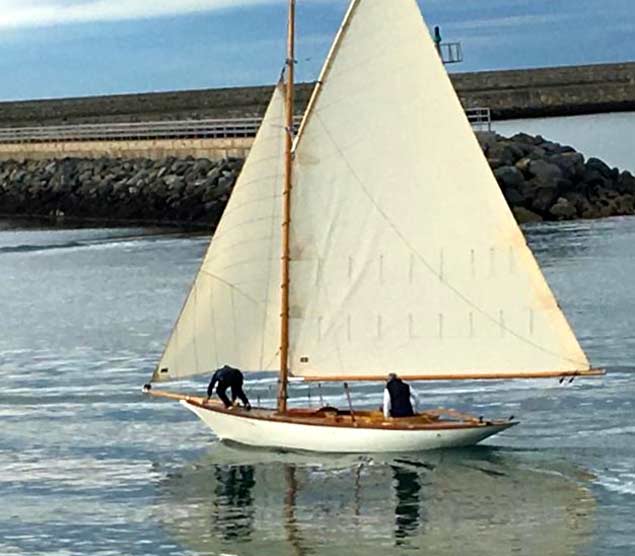 Marguerite has her first sail in restored form, September 2019. Photo: David Williams
Marguerite has her first sail in restored form, September 2019. Photo: David Williams
This boatbuilder was quite something. His busy little yard was in Malahide, but though he was called Jack Wellington, that was an adopted surname, for he was actually Norwegian or Swedish, though nobody quite knew which. It was an easy enough confusion to make, for until 1905 they were a united kingdom with Sweden the dominant partner. But in the small estuary community which was then Malahide, it didn’t much matter either way, as they were accustomed to seafaring men who appeared from God’s knows where, and found a peaceful place to settle in the little village, particularly if they were shipwrights before they were sailors, for the little boatyard was always busy.
Eventually, Jack took it over, and was doing well with fishing boat work such that in 1896 it was decided to build a little yacht. Whether it was for a customer or for Jack himself we don’t know, but we do know that for at least a quarter of a century thereafter, Jack Wellington was the main man on board when Marguerite went sailing and racing.
For her lines, he’d persuaded Herbert Boyd across in Howth – who had designed and built the remarkably accomplished 27ft Eithne in 1893 – to lend him Eithne’s very basic drawings, and he simply scaled them down a bit, and Marguerite was a 25ft version of Eithne.
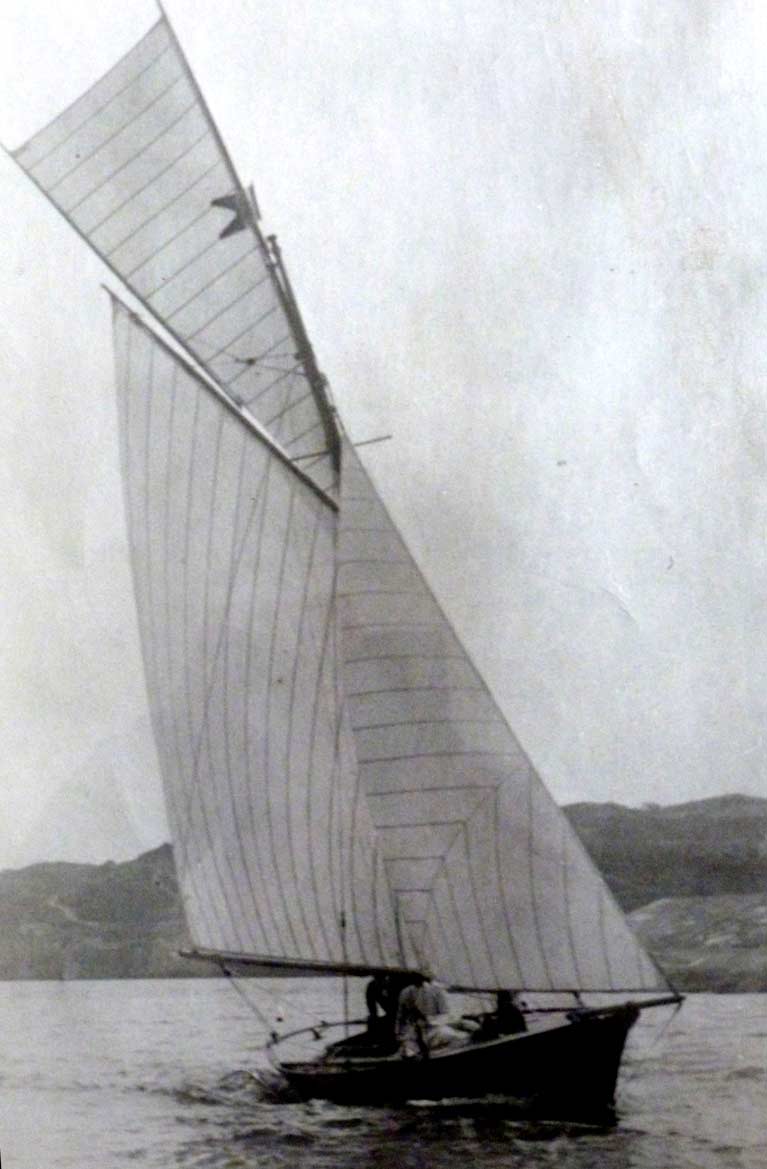 Herbert Boyd’s Eithne as she was in 1895, flying the Commodore’s burgee of the newly-established Howth SC
Herbert Boyd’s Eithne as she was in 1895, flying the Commodore’s burgee of the newly-established Howth SC
Herbert Boyd went on to design the Howth 17s in 1897, and they first raced in 1898. But though he would take the helm of one of them from time to time for a race, Eithne remained his first and truest love. She was possibly the smallest-ever yacht listed as owned by the Commodore of the Royal Alfred YC when he was elected to that role for a distinguished period in office, having by now inherited his father Judge Boyd’s baronetcy to become Sir Walter Boyd Bt. In fact, he kept Eithne from when he had built her in the boatshed beside Howth House in 1893 until his death in 1948, and until the late 1920s her closest rival in racing was often her little sister Marguerite from Malahide.
In time, Marguerite passed to members of the Jameson whiskey family, but continued to be based in Malahide, and in the late 1940s she was being sailed by a young Mungo Park - a direct descendant of the legendary explorer, he was Mungo Park VII - but Marguerite came to him through the fact that his mother was a Jameson. He soon moved on to larger boats, becoming one of the keenest owner-skippers in the Dublin Bay 24 Class, and in 1973 his Chance 37 Tam O’Shanter was the top-placed Irish boat in that year’s Fastnet Race, thereby making Mungo Park the first winner of the Gull Salver.
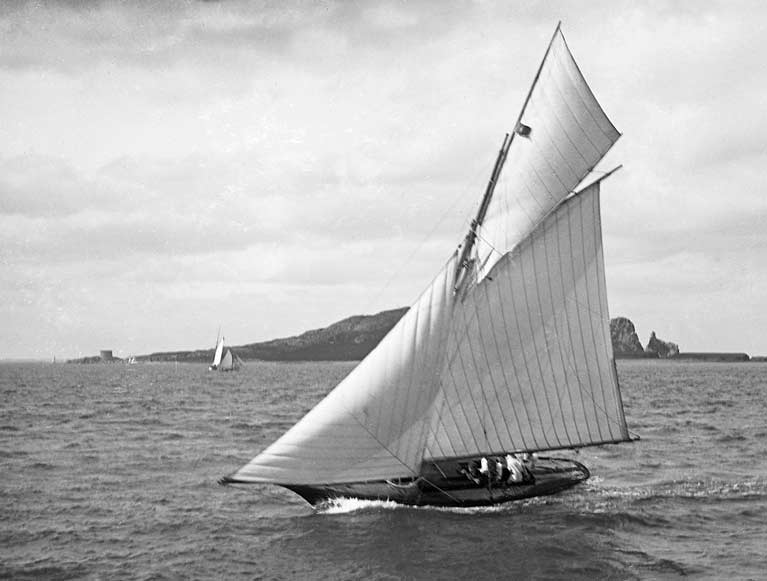 Marguerite in 1896, the only surviving photo of her earliest days.
Marguerite in 1896, the only surviving photo of her earliest days.
As for Marguerite, she was inevitably showing her age and was sold away from Malahide. But somehow she survived, and in the late 1990s, the newly-retired Tim Magennis of Dun Laoghaire – probably the only Irish sailor to have gone round the world under gaff rig, having done it in the 1960s in the Colin Archer ketch Sandefjord – was looking for a retirement project. He was inspired by the fact that Sean Cullen, the son of his skipper on Sandefjord, had restored Eithne in 1984, and when he got to hear that Marguerite was in Arklow in a somewhat sorry state but still eminently restorable, his life path was mapped out for the next twenty years.
He managed to get Marguerite moved to a shed in the old ESB pole-field on Dublin’s East Wall Road, where a select group of Poolbeg Y & BC members winterized their yachts, and there he was able to draw on East Wall’s long-established boat-building skills to bring Marguerite back to life. Her original elegant counter had long since been shortened, but Tim wanted it restored. So I was delegated to bring Mungo Park in from Howth for a conference on how that stern had originally looked, which resulted in what must have been the one and only yacht design consultation which had ever taken place in the Wharf Tavern with a member of the Royal Yacht Squadron leading the discussion.
Despite such high-flying advisers, as he lived on his retirement pension Tim was determined to keep the Marguerite restoration within very manageable expenditure and running costs, so paint was readily used instead of expensively applied varnish, and the “new” suit of sails was assembled from anything remotely suitable on the second-hand market – it is believed that the enormous light weather staysail originally graced an International Dragon, while the mainsail was on permanent loan from a Howth 17.
 Marguerite and Eithne together at a Woodenboat Rally in Dun Laoghaire in 2003, shortly after the former’s 1999 restoration. Photo: W M Nixon
Marguerite and Eithne together at a Woodenboat Rally in Dun Laoghaire in 2003, shortly after the former’s 1999 restoration. Photo: W M Nixon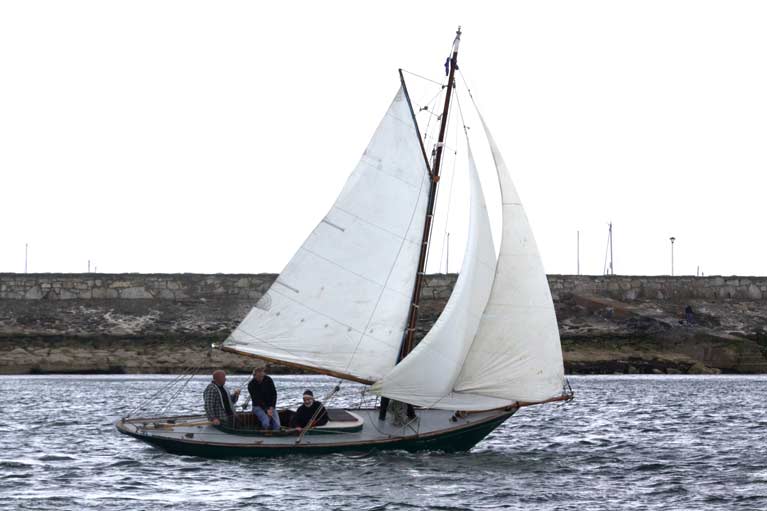 Marguerite as she was in 2013, run as economically as possible and using a mixture of sails. Photo: W M Nixon
Marguerite as she was in 2013, run as economically as possible and using a mixture of sails. Photo: W M Nixon
However, a neat little new engine was installed in order to avail of a tight-fit mooring in the Coal Harbour – not something granted to everyone, but there were many who wanted to help Tim Magennis – and for fifteen years and more, Marguerite in her basically-restored but neatly maintained style was a welcome feature among the newer craft and the utilitarian boats of the Irish National Sailing School in the inner harbour.
Tim Magennis being an enthusiastic member of the Old Gaffers Association, for the season of 2012-2013 he was President of the Dublin Bay OGA when the cream of the OGA fleet came to Dublin Bay as part of their Golden Jubilee, and the little Marguerite gallantly played her role as the flagship of as diverse an assembly of boats as the Liffey has ever seen, with Sean Walsh of the DBOGA becoming the OGA’s President, an international role.
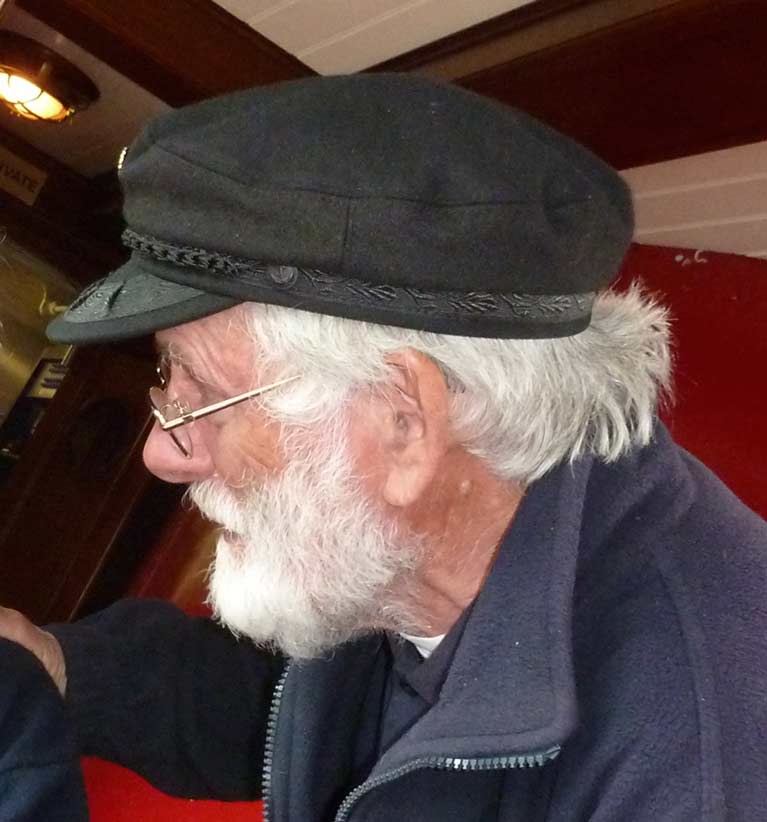 Tim Magennis in his role as President of the Dublin Bay Old Gaffers Association. Photo: W M Nixon
Tim Magennis in his role as President of the Dublin Bay Old Gaffers Association. Photo: W M Nixon
In time, Tim Magennis became an Honorary Member of the OGA, but with his 90th birthday approaching, he was acutely aware that continuing to maintain the Marguerite was becoming too demanding, yet he realised that finding the right people to take her on and maybe give her a full-on classic boat restoration was going to be no easy task.
Looking back now, perhaps it’s a pity that Tim’s main career was in the publicity department of Bord Failte in its developing days, for although he was brilliant at his job, he would have been of great value to the Department of Foreign Affairs, as his skills as a diplomat, persuader and selector of People Who Get Things Done are world class. Having observed the remarkable selection of boats taking part in the OGA Golden Jubilee, he had reckoned that Ian Malcolm of the Howth 17s was in a league of his own in his networking abilities, and at some gaff-rigged gathering he took him aside and asked did he know of anyone who might take on the mission of bringing Marguerite to her true glory, and keeping her there.
Not only is Ian Malcolm one of the main movers in keeping the vintage Howth 17s intact, but he is a committed owner-sailor with the classic Water Wags in Dun Laoghaire, and among their number he knew that Guy Kilroy – who thought so much of the Water Wags that he’d had a completely new boat to the 1900 Maimie Doyle design built by Jack Jones of North Wales - but now was showing the signs, readily recognised by a fellow enthusiast, of needing a much more demanding new project.
And that project was right there with the Marguerite, which always needed work done just to keep her seaworthy, but needed a major job to lift her into classic boat status. By 2017 the outline of an agreement had been worked out between Tim and Guy. But the prospects for the project were made no easier by the fact that Guy and his wife Jackie preferred to have the job done in the Greater Dublin area so that he could keep a close eye on it, for decisions would be needed on an almost daily basis.
 Boatbuilder extraordinaire – Larry Archer is a skilled shipwright in almost every material
Boatbuilder extraordinaire – Larry Archer is a skilled shipwright in almost every material
Fortunately, that star-of-all-trades in boat-building, Larry Archer of Malahide, had secured himself the use of a substantial shed out in the country behind the back of Dublin Airport, a pearl beyond price in a city almost totally devoid of proper marine industry premises. In it, Larry and his right-hand man Paul Fowley were always busy with keeping the Howth 17s in full working order, building a sweet little dinghy to go with the original Asgard in Collins Barracks in order to match the dinghy seen in the famous photo of Erskine & Molly Childers when they were cruising the Baltic in Asgard, and generally getting on with getting things done things.
Bringing Marguerite up to a standard which she had possibly never reached in her long life was right up Larry’s street, and in due course she became the main job in the shed, always gradually progressing even as other more minor jobs came and went.
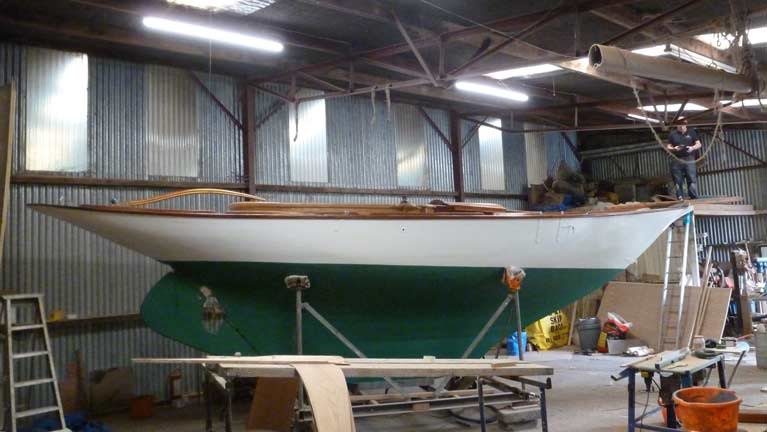 Getting there – Marguerite in the shed “somewhere beyond the airport”, Spring 2019. Photo: W M Nixon
Getting there – Marguerite in the shed “somewhere beyond the airport”, Spring 2019. Photo: W M Nixon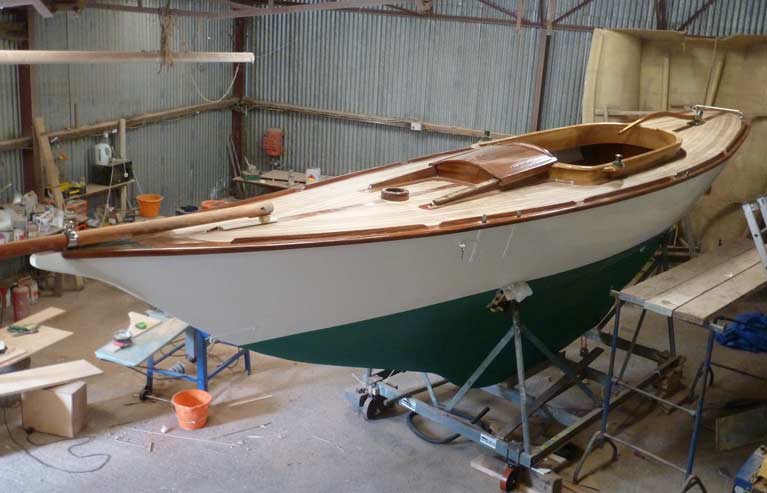 The new deck, hatch and cockpit set the style for the restoration. Photo: W M Nixon
The new deck, hatch and cockpit set the style for the restoration. Photo: W M Nixon
The ambition was to make Marguerite as close as possible to what she had been in 1896. The boat herself was of course available for the basic concept, but despite that high-flown design conference in the Wharf Tavern twenty years ago, there was a feeling that the counter still wasn’t exactly 1896. As for the coachrooof, judging by the only 1890s photo available, the comfortable little cabin as maintained by Tim Magennis was very different from the rather austere virtually flush deck with sliding hatch arrangement indicated in the original.
As well, Marguerite has rather slim sections aft, which greatly helps her speed in light airs, but it meant that the little engine installed in 1999 tended to make her sit a bit by the stern, so Guy Kilroy was very clear that he wanted a new engine installed further forward.
Regarding the cockpit and deck generally, both were to be finished to the highest standards, while in the hull itself, any timber over which there was the slightest question was to be replaced, the ballast keel was to be new bolted, the hint of a clipper bow in the original was to be very definitely retained, and the question of a classic counter – a vague design area with both the restored Eithne and Marguerite - was solved by replicating as far as possible the counter on the Dublin Bay 21s, as good as was ever seen in Dublin Bay.
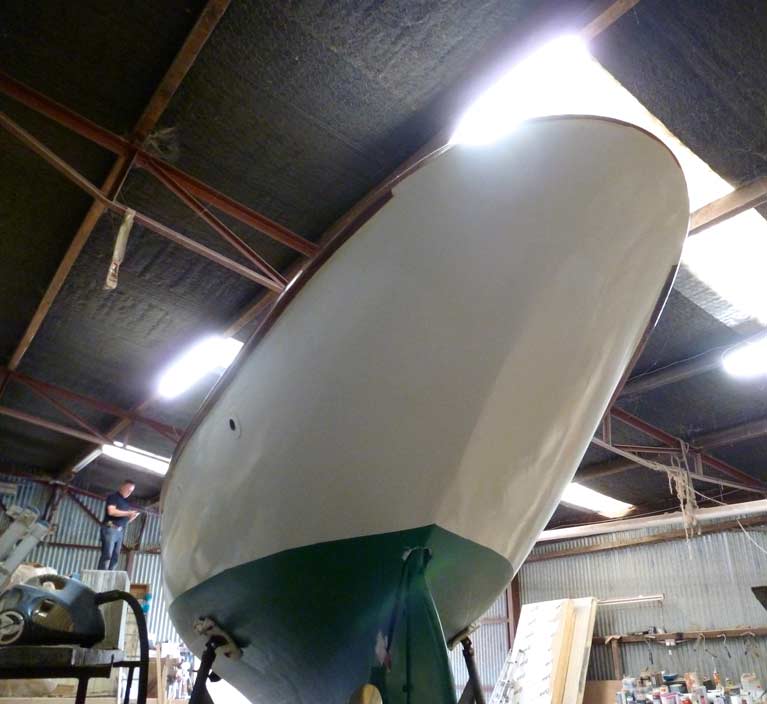 At last….inspired by the lines of the Dublin Bay 21, Marguerite finally has a truly classic counter again. Photo: W M Nixon
At last….inspired by the lines of the Dublin Bay 21, Marguerite finally has a truly classic counter again. Photo: W M Nixon
The original gaff sloop rig was to be re-created using old photos, and the sails and spars in classic style were ordered from Paul Robert’s renowned L’Ateliers d’Enfer traditional marine industry and boat-working school complex in Douarnenez in Brittany, where Ian Malcolm was regularly visiting as it was the location for the re-build on the Howth 17 Anita, lost except for her ballast keel in the destruction of the pier-end boat store shed in Howth during Storm Emma in March 2018.
Thus in the end several different places contributed to the re-birth of Marguerite, but the real focus of the action was in the shed in the unlikely setting of that hugely productive agricultural territory west of the airport, and it was summer 2019 before Marguerite could finally be moved to her designated home port of Dun Laoghaire for the final finishing jobs and the sometimes trial-and-error fitting of the new rig.
She’d been finished in pure white topsides with copper-green underside in proper classic yacht style, but it was expected that the boot-top would have to be raised once she was in full day-cruising trim, and as the photos show, such is the case, and she’ll look even better for it.
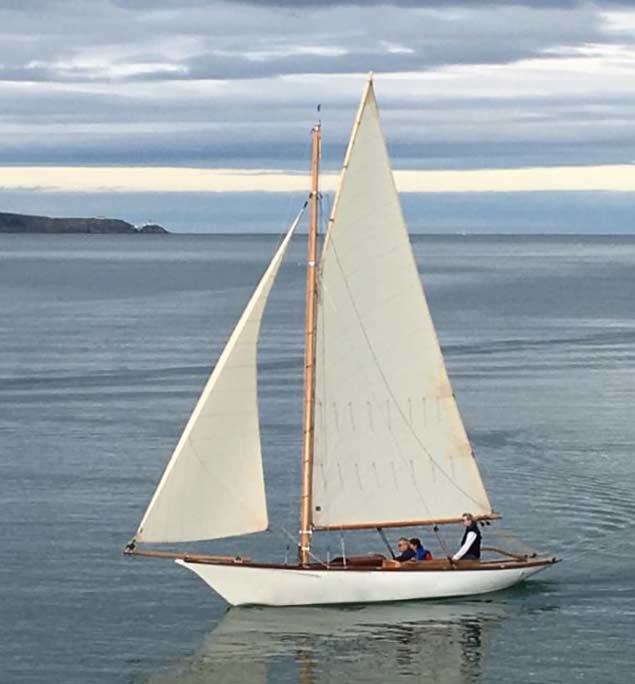 She moves easily through the water with very little fuss, and when the boot-top has been raised as expected, she’ll look even better. Photo: David Williams
She moves easily through the water with very little fuss, and when the boot-top has been raised as expected, she’ll look even better. Photo: David Williams
What with other distraction inevitable in a busy sailing season, it was well into September when Marguerite finally sailed again, and there’s still work to be done. But in due course Dun Laoghaire will have yet another addition to its increasingly varied line-up of true classic yachts, and with two official surveys now under way as to the harbour and harbour area’s future, we can only hope that this increasing interest in classics will be recognized as yet another asset for the harbour as it might be.
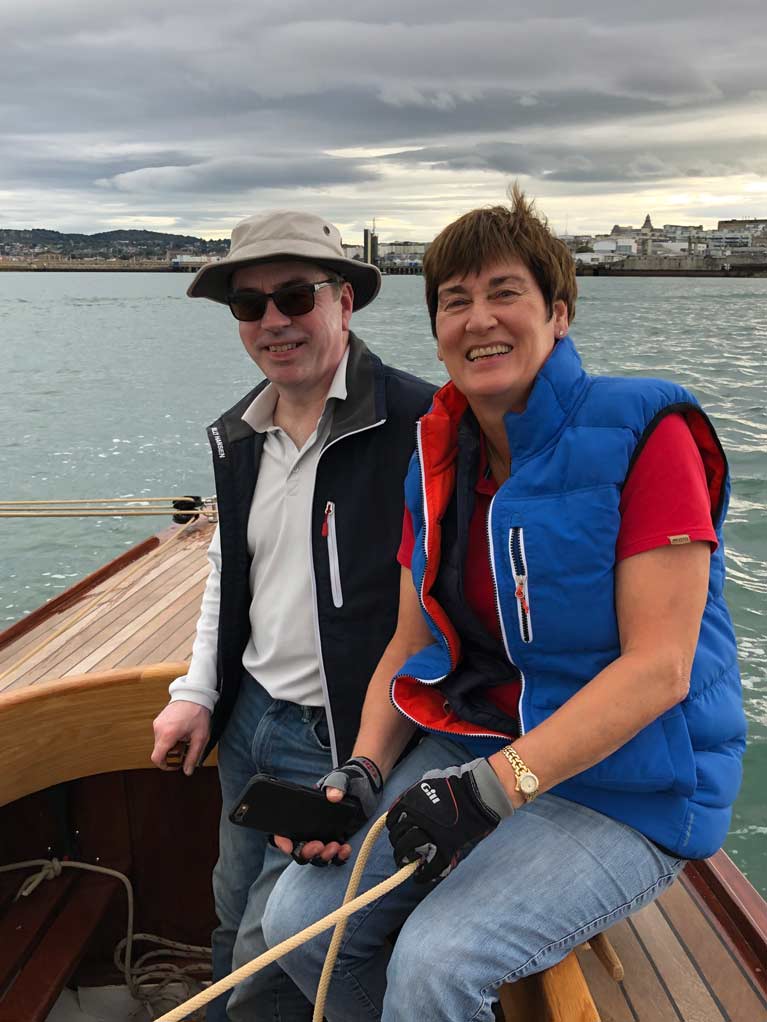 Has it really happened? Guy and Jackie Kilroy on their first sail in their restored 1896-vintage Marguerite. Photo: Ian Malcolm
Has it really happened? Guy and Jackie Kilroy on their first sail in their restored 1896-vintage Marguerite. Photo: Ian Malcolm
For Dun Laoghaire is a classic artificial harbour – indeed, it could probably be best described as a neo-classical harbour. A magnificent structure in itself, it is great augmented by the style and vitality of the three waterfront yacht clubs, each a splendid classical building in its own right.
So although new buildings and new boats will be needed for new and useful additions such as the proposed National Watersports Complex, proper attention should also be paid to the potential for a focal point for classic boats and yachts, and their special requirements.
The historic Water Wags are already a great strength of the harbour scene. The attractive International 12s – once such a feature of the harbour in times past – are making a comeback. The first of the restored Dublin Bay 24s – Periwinkle – is now back in the harbour. The reintroduction of the Dublin Bay 21s is only a matter of time. And the clinker-built Mermaids of 1932 and the IDRA 14s of 1946 also spring to mind for possible revival.
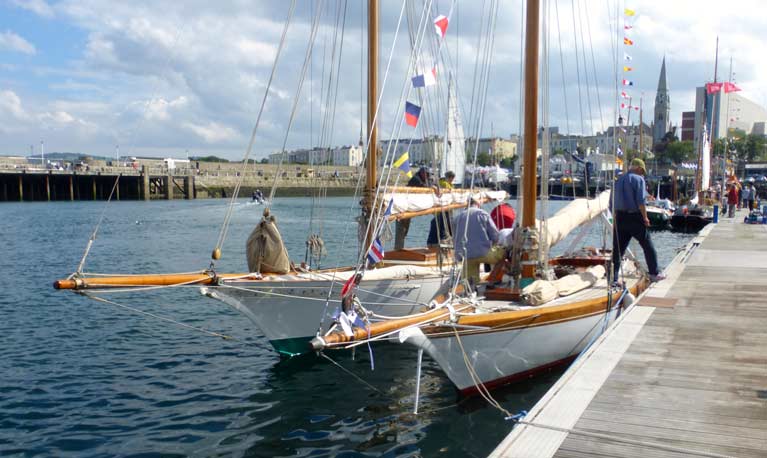 A glimpse of what might be – Peggy Bawn (1894) and Myfanwy (1897) together in Dun Laoghaire in 2017. Photo: W M Nixon
A glimpse of what might be – Peggy Bawn (1894) and Myfanwy (1897) together in Dun Laoghaire in 2017. Photo: W M Nixon
Thus the arrival of Marguerite gives a new dimension to possibilities which were first revealed when Hal Sisk in 2005 brought the superbly-restored 1894-vintage Peggy Bawn back to the harbour which had been her home port since 1919, a dimension which had been emphasised when she got together with the 1897-vintage Myfanwy at the Harbour’s Bicentenary in 2017.
Dun Laoghaire’s past, and the living history of its sailing, become central its future. The story of the restoration of Marguerite, and what she has now become, has been drawn into the Dun Laoghaire Harbour story. And the story of Marguerite and her survival and restoration is a credit to all involved.






























































